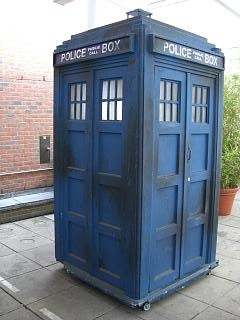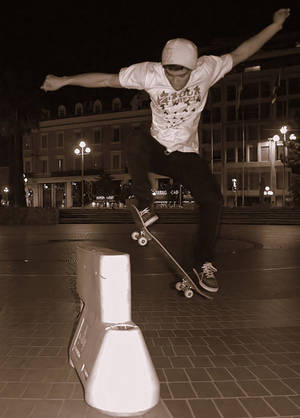Sonic Screwdrivers, Spiderman and Skateboarding Scientists
Interview with
Kat - Dr Who's been capturing imagination for decades but is it all just fiction? Dr Paul Parsons thinks not as Ben found out.
Ben - I'm here at the Science festival with Dr Paul Parsons, author of the Science of Dr Who. Is there really any science in Dr Who or is it all fiction?
 Paul - Actually there's a surprising amount of science in Dr Who not just the obvious topics like regeneration and space flight and things like that. There are actual real science screwdrivers being used in modern factories, There are protective shields for tanks that are being developed that can dissolve projectiles just like the Daleks did back in the first three series. There's all kinds of things going on. I was just staggered when I started ringing up scientists and finding out this kind of thing because I thought it was going to be quite limited, the kinds of stuff that I could talk about. I was literally blown away by how much there is out there.
Paul - Actually there's a surprising amount of science in Dr Who not just the obvious topics like regeneration and space flight and things like that. There are actual real science screwdrivers being used in modern factories, There are protective shields for tanks that are being developed that can dissolve projectiles just like the Daleks did back in the first three series. There's all kinds of things going on. I was just staggered when I started ringing up scientists and finding out this kind of thing because I thought it was going to be quite limited, the kinds of stuff that I could talk about. I was literally blown away by how much there is out there.
Ben - So if we're using sonic screwdrivers now is that a case of art influencing science?
Paul - I don't think they were already in action when they started including them in science fiction. They probably didn't result from science fiction. I think this is just something that people have developed. I say sonic screwdrivers, they're kinda sonic tools. The use sound energy for soldering electrical components in place and that kind of thing. You can use them for cutting fabrics and that sort of stuff, you know. They're little side beams - to make something with as much oomph as the Dr has would be a lot harder. Back in the old series he blows up landmines with the sonic screwdriver from a distance of about 20m. Getting something powerful enough to do that, you'd probably need a nuclear generator which a modern Tom Baker could probably fit in his pockets. Probably a little way to go before you have a real sonic screwdriver like we see in Dr Who. The basic sorts of things are being used, yeah sure.
Ben - Surely the laws of physics don't let us have a thing like the Tardis where it's actually bigger on the inside than it is on the outside.
Paul - It's something you can do in principle actually. There was a guy back in the late 90s came up with a way of arranging this special type of material. He calls it exotic matter because it has negative pressure which means if you blow up your car tyres with the stuff they actually get flatter which is quite bizarre in itself. This chap Chris van-den-Broeck at the University of Cardiff figured out a way of using exotic matter in just the right way that it would actually bend space and time into this bubble which was actually bigger on the inside than it was on the outside. The trouble is you need probably about 10 million billion kg of exotic matter to do this which is about the size of a medium-sized asteroid. It's not something we're going to do anytime soon. It's possible in principle.
Ben - If these things were to be possible what would be the one thing from Dr Who that you would like to see in common use?
Paul - That's interesting...hmmm. Time travel would be good but that's probably maybe a bit obvious, One thing I would like, there was an episode of Dr Who called Nightmare in Eden where there was this machine which was kind of like a virtual safari park where it could capture locations from all around the universe but then project them but project them as a hologram. You could actually go in and walk around. You could visit places virtually, if you like, without having to get on planes and pollute the environment and all that kind of thing. I think I'd have one of them.
Ben - It does sound like a very good way to cut down on your carbon footprint!
Paul - Yes, Dr Who can have the carbon footprint licked. How clever is that!
Ben - Also at the science festival is the editor of materials today, Jonathan Wood. What have geckos, spiders, sharks and daffodils got to do with materials?
Jonathan - Well, I thought that was a good question too but it turns out that all of those things have come up with amazing engineering solutions that we can learn from and make new materials for ourselves. For example, a shark has got dimples on its skin that breaks up the flow of water over its skin, reducing the drag so it uses less energy. Speedo reckons it can make better swimsuits making its swimmers go faster using something similar.
Ben - Should we expect to see Olympic athletes in shark suits?
Jonathan - The all-in-one body suits that make them look so hi-tech now, they are based on what Speedo's learned from sharks. We can argue whether they achieve all that Speedo says or not. Certainly there doesn't appear to be the change in world records that you might have expected if it really worked but it's interesting science nonetheless.
 Ben - In Olympic sports it's the tenths of hundredths of a second that make the difference.
Ben - In Olympic sports it's the tenths of hundredths of a second that make the difference.
Jonathan - Absolutely, the tenth of a second is going to mean the difference between a medal. Even if it helps just a little bit, even if you can't quite show it by science, that's going to matter totally to the swimmer.
Ben - With daffodils, they've inspired some beautiful paintings, some poetry but how have they inspired science?
Jonathan - Well, daffodils are interesting. When the wind blows a daffodil doesn't blow over like a tulip might. Instead it twists and turns its head out of the wind. It's got this strength in the stem but it's also inbuilt this type of flexibility that allows it to twist and keep its head up in the wind. We tend to want to do something different when we build something strong. We want it to be stiff. That's an example where nature's done something different because it has different priorities than we do.
Ben - What do geckos have to do with Spiderman?
Jonathan - Geckos are amazing and sticky. They can scurry up the smoothest wall without a second thought. The way they do it is buy having hundreds of thousands of tiny hairs on their toes and these hairs make use of a tiny sticky force called a Van der Waals force. It's tiny on one hair but if you add it up over the hundreds of thousands of hairs it's really sticky. They can cling to walls like Spiderman did but they can hold their weight maybe 50-100 times over. It's a remarkable thing.
Ben - Have we developed the technology based on this effect?
Jonathan - We can now make materials that are hairy much like a gecko's foot. If you create a plastic film with lots of plastic fibres sticking out of it and you make them close enough you can make something stick purely like Van der Waals forces. We're not as good as a gecko yet but we may be able to scale the Empire State Building soon.
Ben - Also at the festival is extreme scientists, Dr Basil Singer.
Basil - Hello. How's it going?
Ben - Very good thank you and you?
Basil - Very well. It's an amazing event this year, you've got so many people here. It's the most packed-out I've ever seen it. Carol Vorderman is on form. What's more, you've got the sight of Dr Who. The queue's really long. I'd love to get in and see it but queue's all the way out the door, around the building and up the block. It's proved to be a massive hit.
 Ben - Well your own show was on the science of extreme sports and that had queues all the way out and down the river. To be honest, it's the only science show I've seen where you had five kids on stage, on skateboards. What inspired you to use skateboards just to demonstrate physics?
Ben - Well your own show was on the science of extreme sports and that had queues all the way out and down the river. To be honest, it's the only science show I've seen where you had five kids on stage, on skateboards. What inspired you to use skateboards just to demonstrate physics?
Basil - Why not? Mechanics essentially can be taught as such a dry subject. It's just the physics of motion. What better way to use analogies than through extreme sports to describe those physics of motions and the dynamics that occur when you're doing some cool sports?
Ben - Do you find that people get distracted by the fact that there are skateboards around or do you think that they take the physics in?
Basil - I like to think that the kids take the physics in. I've talked to parents after the event before and the parents have come up to me and said, 'er I don't think you really got this idea across because I was distracted by that.' And the children say, 'what are you talking about? Angle of momentum - I totally got it! I totally understand moment of inertia now and why I speed up when I bring my hands in when I'm speeding.' The kids just really do, I hope anyway, relate to what I'm saying.
Ben - Other than snowboarding live on stage and bringing your own snow dome what do you think you'll do next? What's the best way to demonstrate physics to kids?
Basil - That's a very good question. I think I'm going to continue doing this physics of extreme sports lecture because it's a great way to explain mechanics. I'd also like to branch out into sound and music. How does sound travel through the air? How do different instruments make those different sounds? I could bring in a guitar and do a massive rock riff. I could bring in my drums and have a mash away at the drum kit. I think that could be really interesting.









Comments
Add a comment